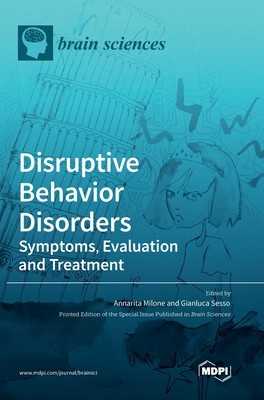
- We will send in 10–14 business days.
- Publisher: MDPI AG
- ISBN-10: 3036536280
- ISBN-13: 9783036536286
- Format: 17 x 24.4 x 1.8 cm, hardcover
- Language: English
- SAVE -10% with code: EXTRA
Disruptive Behavior Disorders (e-book) (used book) | bookbook.eu
Reviews
Description
Disruptive behavior disorders (DBD) refer to a group of conditions that typically share difficulties in modulating aggressive conducts, self-control, and impulses, with resulting behaviors that constitute a threat to others' safety and to social norms. Problematic issues with self-control associated with these disorders are commonly first observed in childhood, but may often persist into adolescence and adulthood, or pose a developmental risk for subsequent negative outcomes. The clinical management of DBD in childhood and adolescence has seen great advances in recent years, and research has also focused on identifying early signs, predictors, and risk factors, which may help clinicians to disentangle and subtype the heterogeneous manifestations of BDB. This has allowed significant progress to be made in defining specific developmental trajectories, targeted prevention programs, and timely treatment strategies. The principal aims of this Special Issue were thus to address three core features of DBD clinical management, the multidimensional assessment of callous-unemotional traits, empathic faults and emotional dysregulation, and the available treatment options. In this Special Issue, twelve relevant contributions, including ten original articles, one systematic review, and one study protocol, which provide novel insights for the assessment and treatment of DBD in clinical practice, have been collected by the editors.
EXTRA 10 % discount with code: EXTRA
The promotion ends in 10d.13:15:23
The discount code is valid when purchasing from 10 €. Discounts do not stack.
- Publisher: MDPI AG
- ISBN-10: 3036536280
- ISBN-13: 9783036536286
- Format: 17 x 24.4 x 1.8 cm, hardcover
- Language: English English
Disruptive behavior disorders (DBD) refer to a group of conditions that typically share difficulties in modulating aggressive conducts, self-control, and impulses, with resulting behaviors that constitute a threat to others' safety and to social norms. Problematic issues with self-control associated with these disorders are commonly first observed in childhood, but may often persist into adolescence and adulthood, or pose a developmental risk for subsequent negative outcomes. The clinical management of DBD in childhood and adolescence has seen great advances in recent years, and research has also focused on identifying early signs, predictors, and risk factors, which may help clinicians to disentangle and subtype the heterogeneous manifestations of BDB. This has allowed significant progress to be made in defining specific developmental trajectories, targeted prevention programs, and timely treatment strategies. The principal aims of this Special Issue were thus to address three core features of DBD clinical management, the multidimensional assessment of callous-unemotional traits, empathic faults and emotional dysregulation, and the available treatment options. In this Special Issue, twelve relevant contributions, including ten original articles, one systematic review, and one study protocol, which provide novel insights for the assessment and treatment of DBD in clinical practice, have been collected by the editors.


Reviews